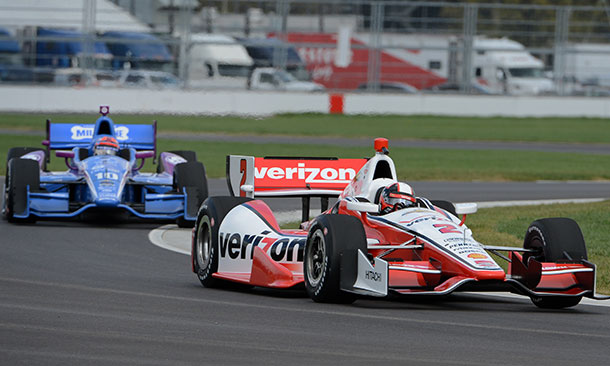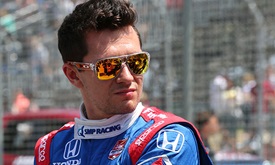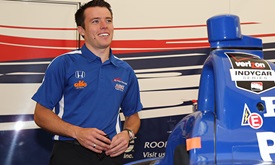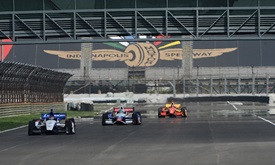Driver input helps shape new IMS road course
MAY 02, 2014
Reconfiguring the Indianapolis Motor Speedway road course was a grand project for Indianapolis Motor Speedway President J. Douglas Roles to commission shortly after moving into his new position, and after a successful test by the Verizon IndyCar Series ahead of next week's Grand Prix of Indianapolis, it was clearly worth all of the hard work put in by an expanded team of collaborators.
"Feedback is unanimously positive, and the biggest thing about this redesign is it involved the amazing staff at IMS, INDYCAR, and many, many drivers," said Boles. "Drivers, in particular, played a very big role; they've always been part of discussion on the oval, but the new road course layout is very much something that they helped shape into something they wanted to race."
The busy road course construction process was completed just ahead of the April 30 Open Test, in which 25 drivers sampled the 2.439-mile, 14-turn circuit.
"We have a couple small tweaks to do, but nothing major," Boles added. "One of them we started tweaking after the morning session changing the way that the cars will exit pit lane. We had them exiting pit lane and blending left into the racing lines just before you got into Turn 1. And the second half of the test day, we had them stay driver's right, inside of curbing, so we're going to add a little bit of concrete in that location to actually make the corner a little more defined to separate the racing line and cars returning to the track from the pits.
"And then at Turn 10, the right-hander where the cars are getting ready to transition on through the south end of the oval, there's an area that we're curbing and then we have a big concrete slab; the driver's ended up calling it 'the sidewalk,' and they were really cutting the inside and making the corner shorter and shorter. So that for the afternoon session we put tires there to stop that and we're going to put in a proper curve there. And we have a little tiny tweak at the pit entrance, but in terms of real changes to the racetrack I think everybody's really pleased with what it is."
Three primary passing areas were put to good use on Wednesday, and should generate plenty of excitement during the 82-lap Grand Prix of Indianapolis.
"The three zones we thought would be the busiest have worked out as we'd hoped," Boles continued. "That's Turn 1, Turn 7 and Turn 12."
High speeds were also a factor on the road course, and could be something fans will want to monitor during the event.
"What really struck me is just how fast it is," said Boles. "Because we've taken out some of the slower corners or reshaped some areas that allow the cars to show their power and handling, it has made the IMS road course very quick. The average speed was 126 miles an hour which is fast for a road course."
Based on the best lap of 1m9596s/126.121mph set by Target Chip Ganassi Racing's Scott Dixon in testing, the Grand Prix circuit offers the highest average speed among road and street courses on the Verizon IndyCar Series championship trail. It also delivers two of the highest top speeds found outside of super speedways.
"Drivers were reaching 196 miles an hour going into Turn 1 before they hit the brakes and and 182 going into Turn 7," Boles noted. "I think once more rubber gets put down and teams develop their setups we'll be seeing over 200 miles an hour into Turn 1."
Boles also took the opportunity to view on-track activity from new viewing mounds positioned inside the circuit and found a few areas that could become quite popular once the Grand Prix gets under way.
"I got to as many spectator mounds and grandstand locations as I could and Turn 1 is still going to be really great passing point anywhere, HJ stand and even the Northwest Vista, you're going to see that passing zone, so that's going to be spectacular," he explained.
"What I found out is if you are in the Northwest Vista you can see Turns 1 through 7, which gives an amazing view. The spectator mound that we just put up between Turns 2 and 3--whoever's lucky enough to get there early and stake themselves a place on the crown of it will be able to see more than almost anywhere else. Bring a swivel chair because you could just watch the entire first half of the track from the top of the mound. It's spinning in a circle.
"The grandstands at Turn 7 and the spectator mound on the inside by the golf course is going to be really good. That one is taller and wider now than it used to be. The mound inside of the oval Turn 2 is a really, really cool view… You can get up close and see these cars do some pretty amazing things from any vantage point on the circuit."
Boles suggests touring the infield during the Grand Prix, which features a standing start on May 10—one day before opening day for Indy 500 practice.
"If you are a big race fan, get a general admission ticket, get a small cooler and go from corner to corner and check out the spectator mounds," he suggested. "Especially Thursday and Friday. Fans have just got to get out and see the cars in the different configurations on the road course because it's an amazing experience."



















